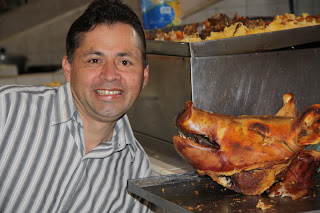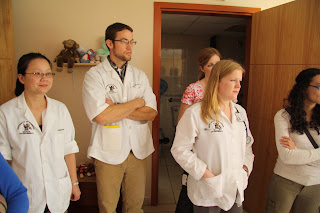
First impressions. No matter how much we read ahead of time, how many pictures we viewed or how many people we talked to, today was very different than any of us had expected. Our duffel bags loaded to set up our mobile clinic, we first headed to Camp Hope for a tour before seeing patients at a near by church. It was much smaller than we had anticipated from the pictures-- hidden behind white washed cement and cinder block walls with a view of the surrounding mountains, this tiny little enclave in the middle of a city of 1 million people treats, teaches and loves the poorest and most severely disabled children. The narrow halls were stacked with boxes and supplies, five large pots bubbled with delicious smelling food attended to by a single cook in a spotless kitchen, tiny classrooms had kid sized sinks for children to learn to do dishes and practice brushing teeth, another room lined with mattresses on the floor for occupational therapy, a small weedy playground with children sitting in a neat row in their wheelchairs, surrounded by caretakers-- two from Germany here for a year long internship. A neat, blue painted infirmary had a nice stock of medications and a nurse. A friendly dog begged for attention from his small pen. We saw the new tile floor they were able to lay over cement with the team donation money. The buildings and rooms used to be a house-- they lifted up a trapdoor in a plywood floor in one room to show us the swimming pool underneath, now used for storage. Some children grinned and either waved us to them or waved us away; many children were too disabled to notice. I don't think any of them are able to speak words, but their eyes speak volumes.
 |
| Camp Hope Courtyard |
We will see each one for a wellness exam next week. Back in our van, we drove to Camp Hogar, the orphanage. We all thought it was at the school, but it was a short drive away down a very steep hill. The children were all at the school, so the home was empty. Unlike the crowded, cinder block and cement school, the orphanage was spacious, sunny, tiled, new and beautiful. We were speechless. Four bedrooms with 5 neatly made up beds each, cheerful murals painted on the walls, wide hallways for wheelchairs, sun streaming in every window with expansive vistas was not quite what we had expected. The home was built five years ago by the church in Texas that sponsors Camp Hope. It was almost too nice to be believable. Each child taken into the home is severely disabled and abandoned, and here they have comfort, nutrition, warmth, love and care. It may not be a loving mother and father, but it's close. And yes, yet another dog begged for attention in a pen in the overgrown yard complete with a swing fitted for wheelchairs.
 |
| Camp Hogar playground |
Back in the van, already late for the patients expecting us at 11 am, we headed back up the steep hill. We went back down the steep hill-- backwards and in first gear. Eduardo, our driver, tried a second and then a third time. This van wasn't making it up that hill full of these American volunteers who weigh a whole lot more than tiny little special children. We got out and walked up the hill to the Pan American Hwy, located a rickety green metal stairway that crosses the six lane highway and went up and over, staircase wobbling over the cars and trucks zooming underneath. We must have looked like a strange group of hitchhikers on the other side.

I can't describe the outside of the church--most building here hide behind the ubiquitous cinder block walls topped with razor wire, broken bottles or tall fences. Inside, however, was a modern, tiled church with a spiral staircase leading to the second floor. On the way up we glimpsed about 40-50 people sitting politely and very quietly in the chapel, best clothes on, a few in traditional Andean hats and blankets, and a few in the white apron and hats from the nearby market. The pastor was an extraordinary man between 50 and 60, dressed neatly casual, who spoke excellent English and was most concerned that we had all we needed. We, meanwhile, were astounded-- we had been told by previous volunteers to expect the basest of conditions, no exam tables, no privacy, and no sanitation. We gaped at the green tarps that had been neatly hung around the room, creating five private spaces, each with a tiny table, chairs, and an exam table, and a step stool whose practicality became obvious very quickly--indigenous people are very short. The church members had created a space--with shelves-- for our pharmacy. We wasted no time unloading our duffels, getting patients into rooms based on the handwritten number they were given, and getting to work.
 |
| Dr.'s Carrie Wilcox, Mimi Choate and Bridget Shariat |
 |
| Mari with Dr. Christy Weiland and Christine Keldson |
We saw a huge variety of diagnoses today-- strep throat, hungry kids, stomach flu, chronic pain, anxiety, stomach ulcers, a tongue mass that looks suspicious for cancer, back and neck pain in the women who work the market and are on their feet all day, people with envelopes of test results who needed to know what they meant, teenage acne, people with stories they needed to tell, and people who came for "vitaminas" and anything else we might have to make their bones strong. We tried to give everyone a little something-- they had spent their day waiting for the American doctors. The kids loved the little gliders we handed out--Fernando, 8 and the son of one of the church workers, made sure we each had a turn flying the glider to him. The four hungry children, who are the youngest four of nine, each clutched their gliders and smiled for our cameras-- but what they really needed was food. The church will help. The woman with the tongue mass was encouraged to go to a nearby oncology clinic, because if they biopsy the lesion and it's cancer, they are obliged to treat her. We all learned a little more about ourselves as we learned about them.
First impressions--smaller, bigger, heavier, incredibly organized, seeing the needy and the not needy, seeing chronic needs and acute needs, collecting stories, and receiving unmeasurable kindness from our hosts. It was a great first day.
www.camphopeecuador.org
 You haven't lived
You haven't lived the deaf sing.
the deaf sing. We didn't save any lives, but we hugged a lot of people; the supplies we brought and didn't use are going to Dr. Marcus Nelson, who teaches and works in a family medicine residency here in Quito and in the jungle. He and I are already scheming about exchanging residents for rotations. I'm not sure why I was called to do this trip--I thought perhaps I would experience some epiphany; if I had one, I missed it. I did meet wonderful people who will be lifelong friends; I did learn to speak some Spanish; I had a great time.
We didn't save any lives, but we hugged a lot of people; the supplies we brought and didn't use are going to Dr. Marcus Nelson, who teaches and works in a family medicine residency here in Quito and in the jungle. He and I are already scheming about exchanging residents for rotations. I'm not sure why I was called to do this trip--I thought perhaps I would experience some epiphany; if I had one, I missed it. I did meet wonderful people who will be lifelong friends; I did learn to speak some Spanish; I had a great time.











































